I’m an entomologist, and the red back jumping spider, or Phidippus johnsoni, is truly captivating. These spiders are part of the Salticidae family, the biggest spider family with over 6,380 species. They stand out with their bright red color, amazing jumping skills, and interesting behavior.
These spiders live in many places across North America. They are great hunters, using their sharp eyes and quick moves to catch their food. Even though they can bite, their bites are usually not dangerous to humans. They help control pests naturally.
We’ll look closer at the red back jumping spider’s unique traits and how it adapts to its environment. Let’s explore the fascinating world of these spiders together.
Red Back Jumping Spider’s Vibrant Coloration
The red back jumping spider, known as Phidippus johnsoni, stands out with its bright red color. This color is key to the species and helps them communicate. It makes them different from many other spiders.
The Striking Red Hue That Sets Them Apart
The red color comes from special pigments in their skin. This color makes them noticeable and important for survival and finding a mate. The red warns predators that they are not good to eat.
Camouflage and Color-Changing Abilities
These spiders can also change their color to hide. This lets them sneak up on prey or avoid danger. They can change to be almost invisible, helping them hunt and stay safe.
Their bright red color and ability to change color make them interesting. These traits help them survive and play a big role in their world.
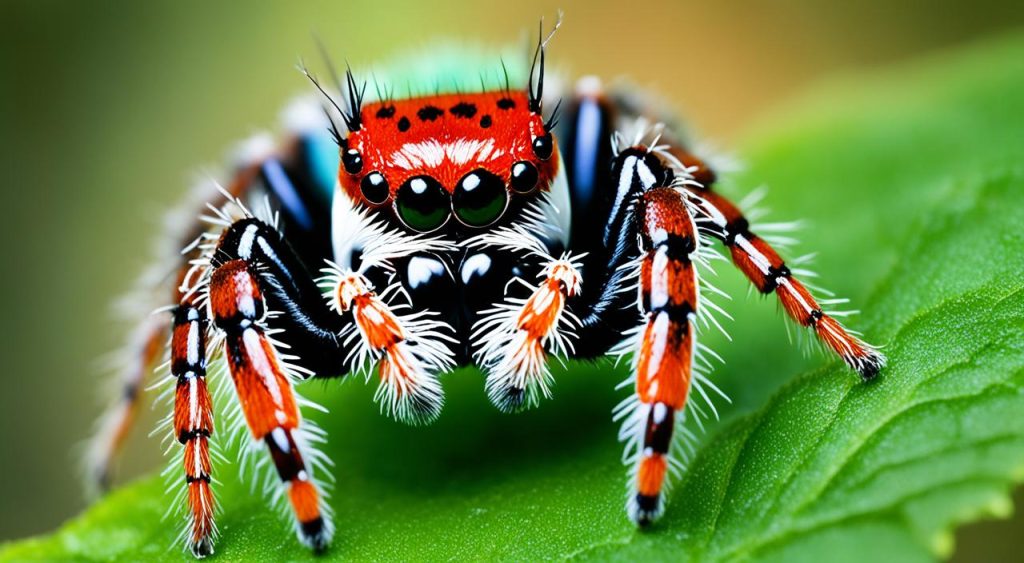
| Species | Coloration | Camouflage Abilities |
|---|---|---|
| Red Back Jumping Spider (Phidippus johnsoni) | Striking red hue | Capable of color-changing to blend in with surroundings |
| Bold Jumper (Phidippus audax) | Variety of colors, including black, white, and orange | Can change color to match their environment |
| Zebra Jumper (Salticus scenicus) | Black and white striped pattern | Excellent camouflage abilities to hide among tree bark and foliage |
Incredible Jumping Abilities
The red back jumping spiders are known for their amazing jumping skills. They use these skills for hunting and getting away from predators. With their strong hind legs, they can jump up to 50 times their own body length. This makes them some of the most agile jumping spiders around.
This skill lets them move quickly, catch prey by surprise, and avoid dangers with great speed and accuracy. Their jumping shows how they’ve evolved over millions of years to be more agile and skilled at hunting.
- Red back jumping spiders can leap almost 40 times their body length in a single jump.
- The Salticidae family, which includes red back jumping spiders, accounts for 13% of all spider species diversity.
- Jumping spiders have four pairs of eyes, totaling eight eyes, which provide them with exceptional depth perception and keen eyesight for hunting and navigation.
This amazing jumping ability is key to how the red back jumping spider hunts. It lets them stalk, pounce, and catch prey efficiently. Their agility and speed make them powerful predators. Their jumping skills are a true wonder of nature.
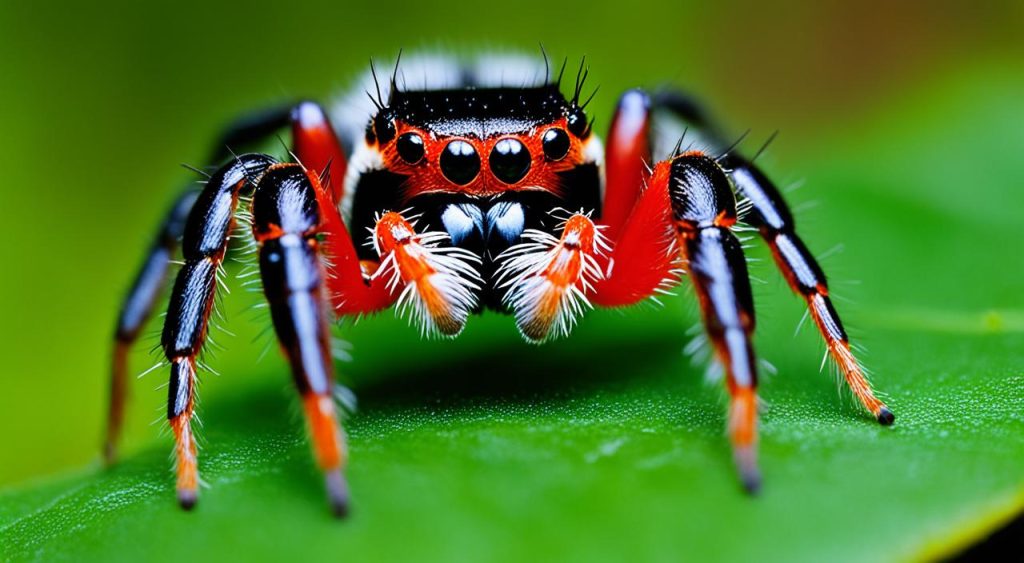
Excellent Vision and Eyes
The red back jumping spiders have an amazing visual system. They have four pairs of eyes that give them great depth perception and sharp sight. Their big front eyes are key for hunting and finding their way around. They help the spiders judge distances and jump with amazing precision.
Four Pairs of Eyes for Depth Perception
Each of the red back jumping spider’s eight eyes has a special job. They work together to give the spider almost a full view of the world. The main eyes at the front see colors and details as well as bigger animals do. In fact, humans can only see about five to 10 times better than these spiders.
Keen Eyesight for Hunting and Navigation
The red back jumping spider’s great eyes help them hunt and navigate. Their main eyes focus on what’s right in front, letting them judge distances and plan jumps. The other eyes look around for food or danger. This helps them see many colors, like red, orange, and yellow, which they use to attract mates.
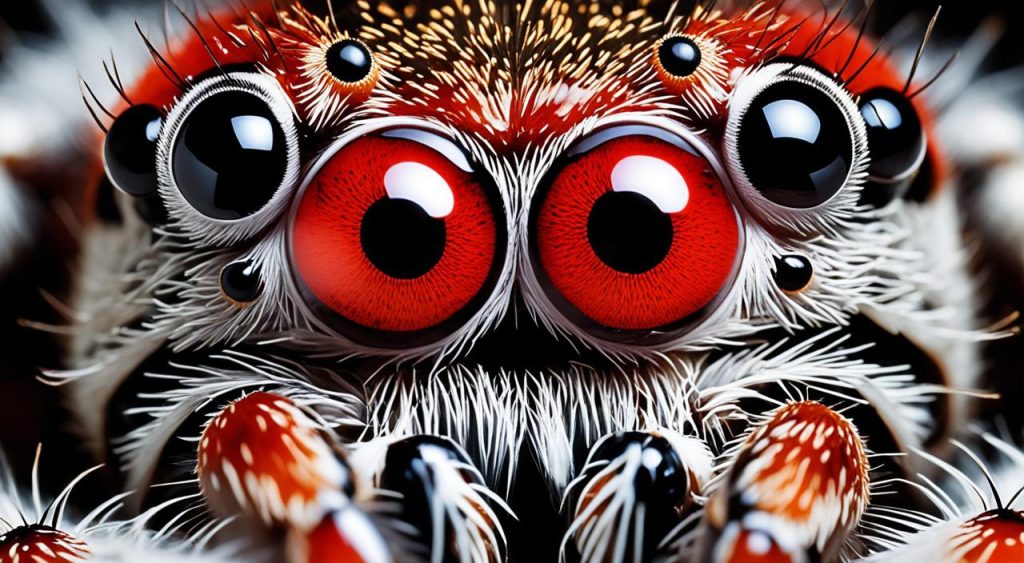
Jumping spiders come in over 6,000 types, from tiny to 20 millimeters big. They have a unique visual system that stands out in nature. The red back jumping spider’s eyes show how diverse and adaptable the natural world is.
Red Back Jumping Spiders
The red back jumping spider, known as Phidippus johnsoni, is a fascinating creature. It belongs to the Salticidae family, the biggest group of jumping spiders. These spiders live mainly in North America. They are known for their bright red color and amazing jumping skills.
A study in 1976 showed that 2 to 30 red back jumping spiders live in every 1,000 square meters. In 2012, NASA sent one of these spiders to space. This shows how interesting these spiders are to scientists.
These spiders are about a centimeter long, both males and females. They are great hunters, eating prey half their size. They can even eat each other, with females sometimes eating the males.
| Characteristic | Details |
|---|---|
| Size | Male and female red-backed jumping spiders tend to be about a centimeter in length. |
| Prey Size | Adults of the species Phidippus johnsoni feed on prey about half their own size, with a range observed from 2 millimeters (0.079 in) to about 1 centimeter (0.39 in). |
| Cannibalism | Cannibalism occurs in red-backed jumping spiders in the form of females feeding on males from time to time. |
| Pricing | Price for a juvenile female Western Red-Back Jumping Spider: $34.99 |
| Shipping | Must be shipped via UPS Ground or UPS Next Day Air. Jumping Spiders ship Monday-Wednesday; orders placed after Wednesday at 12pm EST will ship the following Monday. |
| Husbandry | Common husbandry mistakes: Insufficient lighting, not enough heat, and humidity. |
These amazing red back jumping spiders, also known as Phidippus johnsoni, are a key part of the arachnid world. Their unique traits and behaviors make them very interesting to scientists and fans.
“The red back jumping spider is a true marvel of nature, with its vibrant coloration and incredible jumping abilities.”
Unique Hunting Techniques
Red back jumping spiders don’t spin webs like many other spiders. They hunt actively, using their great vision and speed. They stalk and pounce on their prey with stealth and explosive jumps.
Stalking and Pouncing on Prey
These spiders are experts at being quiet and sneaky. They stalk their prey carefully before striking with power and precision. Their four pairs of eyes help them see clearly and judge distances. This lets them jump at the perfect moment.
Active Hunters Without Webs
Red back jumping spiders don’t need webs to catch their food. They hunt actively, using their sharp vision and quick reflexes. They chase and catch their prey, making them different from many other spiders.
| Hunting Technique | Description |
|---|---|
| Stalking | Red back jumping spiders use stealth and careful movements to silently approach their prey, relying on their excellent eyesight and depth perception to track their targets. |
| Pouncing | When the opportunity arises, these spiders unleash their explosive jumping abilities, leaping towards their prey and delivering a venomous bite to subdue their target. |
| Active Hunting | Rather than waiting in a web, red back jumping spiders actively search for and pursue their prey, showcasing their agility and adaptability as predators. |
Red back jumping spiders use stealth, precision, and explosive jumps to hunt. This makes them skilled predators. They catch a variety of small insects and arthropods, helping them thrive in different places.
Varied Habitats and Adaptability
The red back jumping spiders, known as Phidippus johnsoni, are amazing arachnids. They can live in many places, from coastal dunes and oak woodlands to cities and suburbs. You can find them in gardens, parks, and even buildings.
These spiders are very adaptable. They can live from sea level up to the tree line. This shows how tough and flexible they are. They can handle different conditions and heights, thanks to their evolution.
Seeing red back jumping spiders means the environment is healthy. They react to changes in their area. So, their numbers and where they live tell us about the health of the ecosystem.
| Habitat Type | Adaptability | Ecosystem Role |
|---|---|---|
| Coastal Dunes | High | Pest Control |
| Oak Woodlands | High | Pest Control |
| Urban/Suburban Areas | High | Pest Control |
Red back jumping spiders can live in many places, from nature to cities. This shows how strong and important they are in the ecosystem. They help control insect numbers, keeping ecosystems healthy.
Solitary and Territorial Behavior
Red back jumping spiders like to live alone and hunt by themselves. Each spider has its own territory. This helps them get food and other important things they need. They don’t like to share their space with others because they compete for resources.
These spiders are very territorial. They claim and protect a certain area. This way, they can get to food and what they need without fighting with others. It helps them survive better.
They hunt on their own, not using webs to catch prey. This means they have to find their own food in their territory. It makes them more independent hunters.
Even though they are mostly alone, sometimes they meet up to mate. These meetings are short and only for mating. After mating, they go back to being alone and protecting their territory.
In conclusion, being alone and protecting their territory is key for red back jumping spiders. It helps them get what they need, avoid fights, and live well in their homes. Learning about their social life and how they compete for resources is interesting and helps us understand them better.
| Characteristic | Description |
|---|---|
| Solitary Behavior | Red back jumping spiders prefer to live and hunt independently, establishing and defending their own territories. |
| Territoriality | Each individual spider claims and fiercely guards a specific area to secure access to prey and other resources. |
| Resource Competition | Spiders compete for food, mates, and other vital resources within their territories, shaping their individual behaviors. |
| Occasional Social Interactions | Red back jumping spiders may engage in brief social interactions, primarily during mating rituals, but quickly revert to their solitary lifestyle. |
Red back jumping spiders are very much about being alone and protecting their territory. By doing this, they can get what they need, avoid fights, and do well in their homes.
Fascinating Courtship Rituals
Red back jumping spiders have amazing courtship rituals to find mates. These rituals show off the male spiders’ agility and bright colors. They try to win over potential female partners with these displays.
Intricate Dances and Displays
Male red back jumping spiders do cool dances and shows to get noticed by females. They wave their legs fast, bob their bodies, or jump high to show off. Their bright red abdomens and legs grab the female’s attention right away.
Mating and Reproduction
If a female red back jumping spider likes the male, they mate. The male gives the female his sperm during this. Then, the female lays her eggs in a safe silk cocoon. These eggs stay protected until they hatch.
The mating can last from 5-45 minutes or more. In most cases, it’s peaceful. After mating, it takes 2-4 weeks for the female to lay her eggs. Then, it takes another 4-6 weeks for the babies to hatch and leave the nest.
| Courtship Rituals | Mating and Reproduction |
|---|---|
| Rapid leg waving Bobbing body movements Leaping displays Vibrant red coloration | Mating duration: 5-45 minutes Successful mating: 80% peaceful Egg laying: 2-4 weeks after mating Hatching: 4-6 weeks after egg laying |
Venomous Bites and Predation
The red back jumping spider, Phidippus audax, has a venomous bite to catch its prey. This venom isn’t a big worry for humans but is key to the spider’s hunting. It helps the spider quickly take down its prey, making it easier to eat.
But, these spiders aren’t safe from being eaten themselves. Big animals like dragonflies, lizards, and birds often eat them. If they see a threat, the spiders will run away or use tricks to stay safe.
In their homes, red back jumping spiders keep insect numbers in check. Their hunting helps keep the food web balanced, which is good for the local environment. Even though they don’t help humans directly, they’re important for their ecosystem.
FAQ
What makes the red back jumping spider unique?
The red back jumping spider, known as Phidippus johnsoni, stands out with its bright red color. It’s known for its amazing jumping skills and has four pairs of eyes for sharp vision.
Where are red back jumping spiders found?
You can find red back jumping spiders in North America. They live in many places, like grasslands, forests, and even cities.
How do red back jumping spiders hunt?
These spiders don’t use webs to catch prey. Instead, they hunt by using their sharp eyesight and jumping power. They sneak up and jump on their prey, then bite them with venom to catch them.
Are red back jumping spiders a threat to humans?
Yes, their bites are venomous, but they’re not a big danger to people. They actually help control pests in their natural habitats.
How do red back jumping spiders reproduce?
Males perform special dances to attract females. If a female is interested, she lays her eggs in a protective silk sac.
What is the role of red back jumping spiders in their ecosystems?
These spiders are important because they eat lots of insects. But, they also have predators that keep their populations in check. This shows how they fit into the ecosystem.

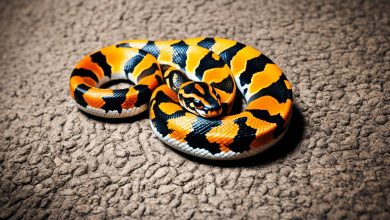

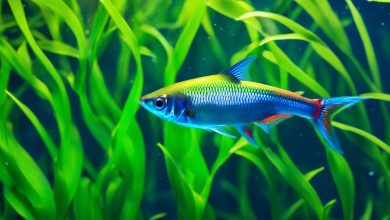

2 Comments